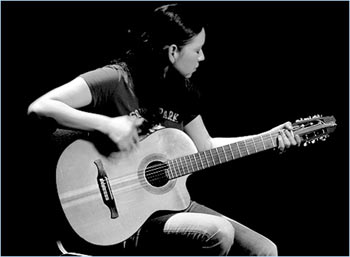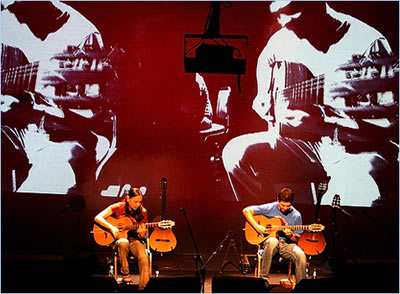|
The stage is
in complete darkness and the audience is hushed in
anticipation, as two young guitar-players take their seats. A
few seconds later, the entire venue reverberates with the
frantic strumming of guitars and the synchronised tapping of
the two performers’ feet. The tunes are literally hammered out
on the instruments, the exquisite music punctuated by the
performers’ humorous personal interjections between songs.
After a succession of encores, Rodrigo and Gabriela take their
final bows on the stage at Vicar Street, Dublin, and retire to
the temporary sanctuary of the dressing rooms and an enormous
bowl of fruit. The audience in the Irish capital is once again
in awe of the talent, energy and mastery of the Mexican
couple, who have returned to play a few gigs in the city where
it all began. Despite their growing popularity and tours in
Australia, the United States, the United Kingdom, and most
recently back in Mexico, Gabriela and Rodrigo continue to find
themselves returning to Ireland.
Gabriela
Quintero and Rodrigo Sánchez first met at the Casa de Cultura
in Mexico City. Mexico City, constructed on the ruins of the
Aztec cities of Tenochtitlán and Tlatelolco, is the capital of
Mexico, and with a metropolitan population of almost twenty
million people, is one of the largest cities in the world.
After each playing in various heavy metal bands based in the
sprawling metropolis, Rodrigo and Gabriela began to perform
together in a band called Tierra
Ácida
(Acid Earth). During the day, Gabriela worked as a music
teacher, while Rodrigo performed music for television
programmes. Yet gradually they began to think of leaving la
Ciudad de México and traversing the
Atlantic to
Europe, in search of adventure.
The pair
arrived in
Dublin,
Ireland
in 1999, to a city and a country in the initial stages of an
economic boom period. This was reflected in a thriving live
music scene in the city’s pubs and clubs. As Rodrigo explains,
‘we didn’t want to come to
London
or Paris or Spain. We come from a very big city, so we wanted
something smaller.’ (Rodrigo y Gabriela DVD). In 2003, the duo
released their first album, Re-Foc, and a year later an album
recorded live in Manchester and Dublin hit the shops. Their
music is an innovative hybrid of the metal music that they
carry in ‘la médula de los huesos [the marrow of their bones]’
(Sergio Burstein, Lavibra.com), jazz and classical acoustic
guitar - but any verbal description could not do justice to
their originality. As Gabriela points out: ‘I hate to think
what kind of music I play or I want to play. All that to me,
is s**t. To be honest. You play what you can express.’
(Rodrigo y Gabriela DVD).
In 2006, with
their eponymous album, Rodrigo y Gabriela beat both the Arctic
Monkeys and Johnny Cash to number one in the music charts of
their adopted country. (Sue Steward, www.rodgab.com/history,
2006). I spoke with Gabriela Quintero in November 2006, and
she candidly told her story:
[Claire Healy] Could you tell the story of your move from
Mexico City
to Dublin City? What had you heard about Ireland before you
arrived here?
[Gabriela
Quintero] I had heard
very little about Ireland. The original idea was to come to
Europe, but to live somewhere different - not in
Spain.
But we didn’t know much about Ireland. We got advice from a
Mexican friend who had lived all over
Europe ten years before that, and who really loved
Ireland and
said that it was very friendly. I didn’t know anything else,
but I should have asked my mum, she is very knowledgeable, and
she always loved Irish writers. When she came to visit
Ireland, she said I should have asked her about it first!
Had you known of any connections between
Ireland and
Mexico?
Yes, I had
heard of the San Patricio Battalion. In a place called San
Ángel
there is a plaque with the names of all the Irish soldiers,
but nobody in Mexico knows this, they don’t teach it in
school. It was a cool thing to happen, though they all ended
up having horrible deaths. The world is very small, you know,
the more you travel, the more you know. I think we only have
borders in our minds, but in reality they are not really
there.
|

Gabriela Quintero
(Enda Casey, www.rodgab.com)
|
What influenced your decision to come here?
We just
wanted to come to
Europe, to travel the world, we were not looking for a job. We come
from a middle-class background in
Mexico, so
when we quit the metal band, we just went to the beach. Then
we found a really good way to make a living by playing music
at hotels. We were sorted and we got paid properly, but we
wanted something else. So we decided to travel to Europe, but
the package trips they sell in
Mexico are always to
England,
France, and other places. We didn’t want to see the
Eiffel
Tower,
we wanted to do something outrageous, like maybe live in
Poland, but we ended up in Ireland! It was definitely the
right decision in the end.
Did you know anyone living in
Ireland
before you arrived?
Not really,
we didn’t know anyone personally. The day before our trip we
met a girl who knew a friend of a friend of a friend - a
Mexican guy living in Dublin. She gave us his telephone
number, he was a student studying in Dublin, we didn’t really
know him at all. We ran out of money in Ireland after the
first week, so we had to go out and busk, but we rang that guy
and he was really cool, he let us sleep in his house for three
days. He didn’t really have to do that, he was a good soldier!
What were your first impressions of the country, and did they change
after you had remained here for a while? What differences do
you see between
Ireland in
1999 and today?
There are a
lot of differences between Ireland in 1999 and today, even
though when we came here in 1999, a lot of people were already
telling us that Ireland used to be different, that everything
was terrible now. Now I have kind of become one of those
people who say ‘it’s terrible, Ireland has changed so much’!
It was our
first time in
Europe so there was a big culture shock and my English was
terrible, I had none whatsoever. Rodrigo spoke a little bit of
English, but the first day was a nightmare. Even just trying
to say the most normal things was a problem, but people were
very nice to us. We didn’t understand anything. After just one
week we had to go and play in the street. My first impression
of
Dublin was that it was really windy, and really cold, and I
thought ‘what on Earth are we going to do?’ We busked on a
Saturday morning at 11am on Grafton Street [the main shopping
street in Dublin]. It was absolutely packed. That changed
everything; many people approached us and were very friendly.
We basically just said yes to any invitation.
Our first gig
was a religious party in Bray [County Wicklow]. We had said
that we would do anything, but on the journey there we
wondered if it was some kind of sect, and we didn’t know what
they were going to do to us! It ended up being a little boy’s
First Communion, and we spent the evening drinking with the
guests! The following day we played at a folk night in the
Norseman pub in Templebar [Dublin’s cultural quarter]. We were
paid ten pounds each and were the headline act, though
everybody thought we were Brazilian!
I don’t
think people are less friendly in Ireland if you come from a
Latin American country. Latin Americans can be very proud, but
it all depends on how you approach the encounter. Really,
nobody cares in Europe or America if you are Latin American or
not. Mexicans often complain about foreigners, and think that
foreigners are being cold just because they don’t tell
Mexicans that they’re great! People can have problems if they
arrive here with a bad attitude. Wherever you are from and
wherever you go, you find good people - and eejits
[Hiberno-English word for ‘idiots’]!
|


